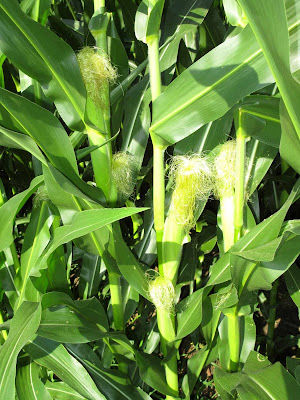July 31
The last week in July brought 15% more growing degree days than normal, and more than two inches of rain, so the plants should have had more than enough resources to continue the ear development. That development appeared to be continuing, and stalk drying was not widely evident.
August 7
By August 7, the ears appeared to be full size and what kernels were visible appeared to be fully formed. Growing degree days totaled about 10% more than the historical average, but evidence of stalk drying was practically non-existent. Rainfall was minimal, but humidity remained high.
August 14
In week 16, the ear husks showed more drying, and the bottom leaves of some stalks showed evidence of drying as well, while higher temperatures resulted in 19% more growing degree days than normal. One thunderstorm produced more rain than typical, and humidity remained high most of the week.
August 21
The week ending August 21 brought a few brief thunderstorms, generally high humidity, and about 10% more growing degree days than average. Leaf drying on the stalks was much more evident, and ear husks also continued drying.
August 28
A few days before these pictures were taken on August 28, a portion of the field was harvested for silage (
similar to last year), but obviously the corn immediately behind our house was left for grain harvesting later in the year. As you can tell from the photos, stalk and leaf drying continued to accelerate driven by temperatures that were near normal, and light total rainfall.



























